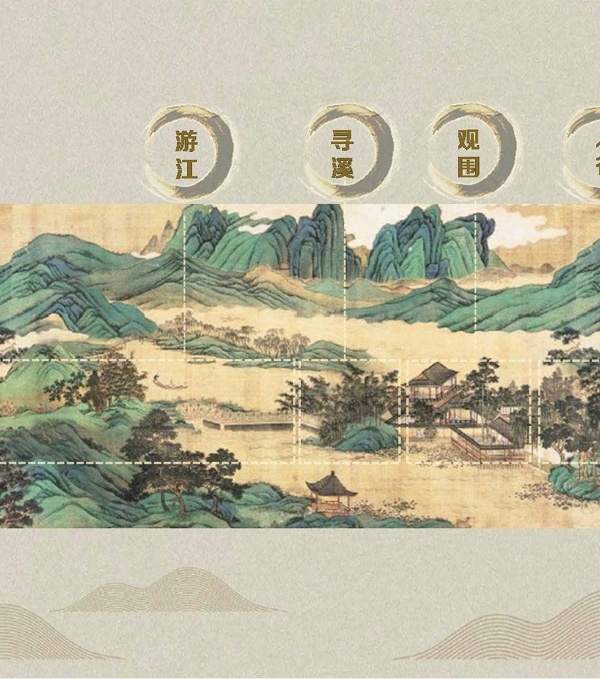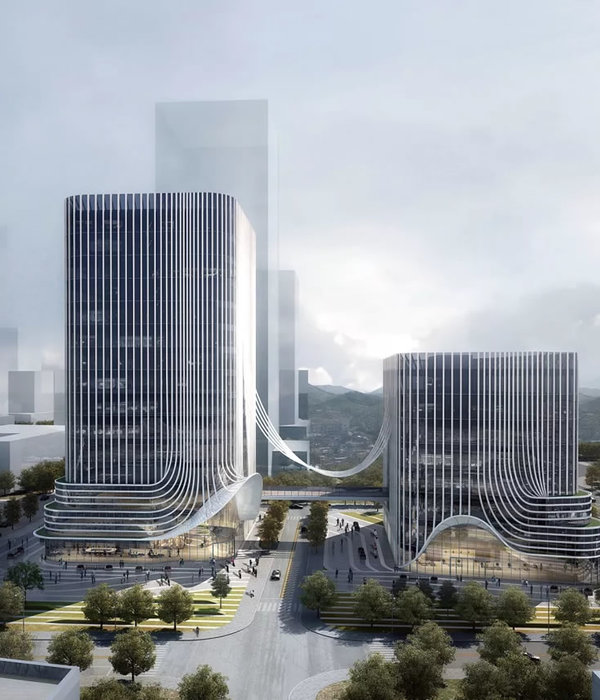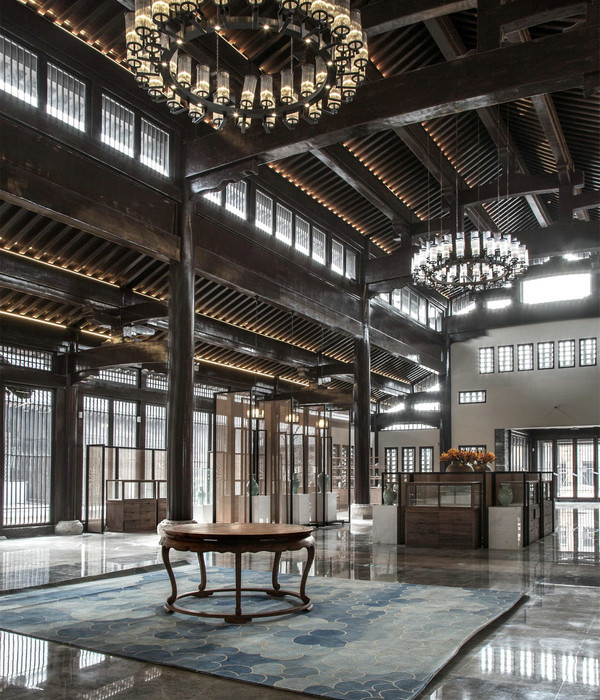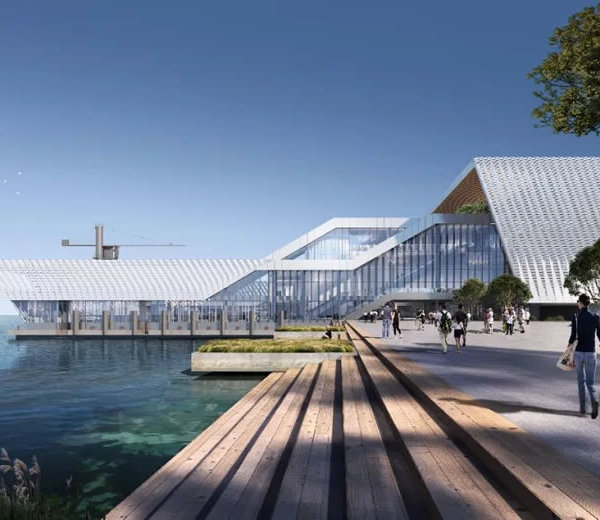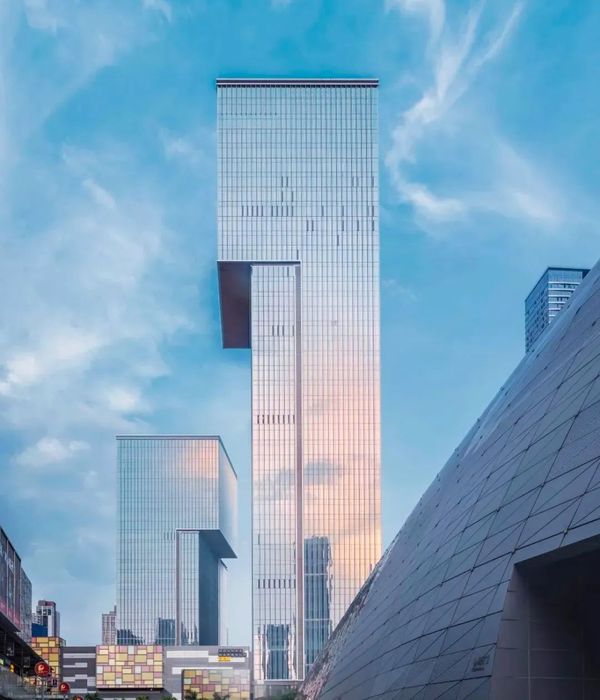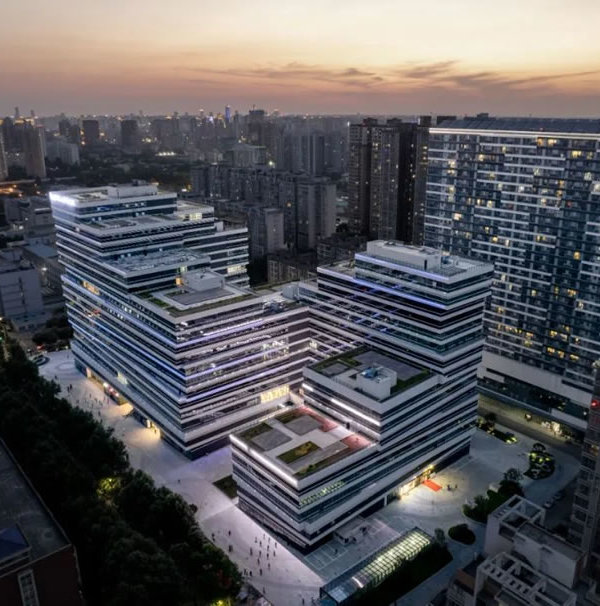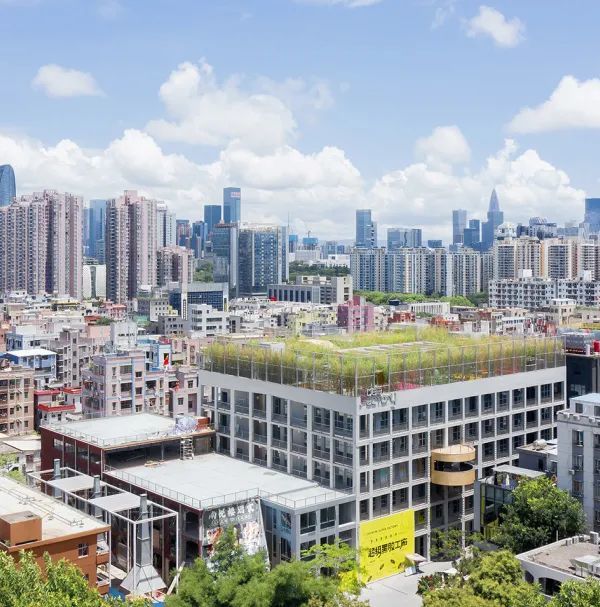An assortment of colorful banners welcomes passengers at the high-speed train station in Tai’an, China. The headlines perched above the Jiunv Crest (Nine Women’s Peak) showcase a Hometown Moon or a Hometown Cloud, inviting people to walk on the moon or wander around the cloud. The intriguing wording is part of a creative campaign inviting travelers to visit attractions lying beyond the main scenic area of Mount Tai. The strategy looks to breathe new life into Nine Women’s Peak, a branch of the famous mount that gives its name to the city of Tai’an.
At the beginning of 2019, Shandong Lushang Group commissioned Syn Architects to develop the overall planning and design of the mountainous area, its villages, and the Hometown Moon, the representative structure of the project. In no time at all, a Hometown Cloud state of mind began to spread out. Fei Xiang’s theme, Hometown Cloud, was played repeatedly in the building. The romantic song from the ’80s swayed people’s emotions, creating a nostalgic atmosphere. Nine Women’s Peak drew attention on social media, bringing new people, new faces, new industries, and new possibilities to the area around Dongximen Village. The region of humble villages became an online phenomenon that attracted thousands of tourists. During the project, Lushang Group effectively used the image of “a cloud” to demonstrate the enormous value of architecture as a communication medium.
However, a series of scattered constructions is not enough to stimulate the growth of a region. Thus, the online popularity of the Hometown Cloud slowed down in less than a year. Today, Lushang Group demands a long-term holistic approach that can connect the string of mountain villages in the 55 square kilometers area. The definition of industrial and spatial structures and the introduction of new wonders that satisfy visitors looking for fresh experiences is needed too. In this regard, Syn Architects integrates daily life, industrial development, and environmental science in every project. Taking advantage of its years of practical experience in rural areas, the firm developed client markets in Jinan, Shandong province’s capital city. Additionally, attractions such as the Balou Theater and the Hometown Moon, and their supporting facilities, were unveiled one after the other. In this way, Syn Architects returns to the birthplace of Confucianism, rebuilding the relationship between dualities such as the city and the countryside, modern society, and homesickness, searching for forgotten values and neglected possibilities.
The original concept for the Hometown Moon comes from the developer. During the Mid-Autumn Festival of 2019, a moon-shaped balloon with a diameter of 10 meters was lit up in Nianhua Bay, spreading magical colors and lights all around. Inspired by the scene, the Lushang Group hopes to light up a full moon at the Nine Women’s Peak and write the next chapter in intellectual property for designed hometowns.
Mr. Zou Yingxi, the lead architect and planner of the project, hopes to infuse a deep meaning into the artificial moon. He longs for a moon that never sets. According to this rhetoric, the building functions as a ceremony hall designed to escape conventionalisms. Among its main features, the structure attracts locals and tourists from other provinces, can host ceremonies and events, and provide spiritual and operational values that strengthen the village’s resources.
An ancient poem from the Song Dynasty ponders about the nature of perspective and emotion: “the clouds and the moon remain the same, but mountains and rivers evolve throughout time.” Modern-day catalysts are also capable of evoking nostalgia, regardless of location. As such, an architectural poem about the moon does not need to relate to the classical symbol. Under this philosophy, Syn Architects combines abstract geometrical shapes and simple materials to create a pure space with complex visuals that stimulate the soul, leaving traditional figurative expressions behind.
The location of the moon is essential. It needs to complement the Hometown Cloud in terms of visitor flow and to engage in a fulfilling dialogue with the natural scenery of the Nine Women’s Peak. Following these two principles, the lead architect Zou Yingxi explored the mountainous area, examining its geographical accidents and architectural possibilities. After careful consideration, the final location chosen was a viewing terrace overlooking the Hometown Cloud on the side of a mountain stream, near the entrance of the stream.
In this way, the Hometown Cloud becomes the viewing spot for the Hometown Moon and a starting point to chase after it. Looking from the top of the mountain, the Hometown Moon and the moon in the sky establish a dialogue between manufactured and natural symbols, blending with the environment and sustaining the aesthetic integrity of the valley. Heading down toward the Hometown Moon, the structure playfully disappears from time to time among trees and branches. It gradually becomes bigger until the manufactured wonder fills in on the complete view, presenting locals and visitors with a romantic depiction of home. Once visitors reach the Hometown Moon, it is possible to look back at the Hometown Cloud. Then, the desire to chase the Hometown Cloud comes to mind again. To this extent, the buildings complement each other as symbolic counterparts.
The parking lot is the last reminder of modern civilization. To access the Hometown Moon, visitors must go through a purifying road. It takes about five to ten minutes to walk along the path between mountains and streams. The entrance lies behind a boulder. From here on, visitors begin to enjoy communion with nature. Birds singing, insects chirping, rustling leaves, gurgling streams, and hearts beating with joy and anticipation; the sounds of nature make visitors feel at ease. After crossing a mountain, a river, and exploring a few curved pathways, visitors finally arrive at the building. Here, they ponder about the intriguing nature of the architecture. And on the emotional side, their senses of hearing and smell are stimulated by their natural surroundings.
The long and winding paths increase the curiosity of visitors. Attracted by a building in the middle of nature, they suddenly find themselves inside the structure, wondering about the charms of an inverted moon. Like Buddhist meditation, the experience develops insight by feeling the background of mountains and forests to complete a mental reorganization, soothing the souls of urban residents. Along the plank road, there are playgrounds, cabin camps, bonfire areas, and anti-fog devices. These and other similar spaces enrich the experience and the dimension of the project.
When the surroundings become gray, the visitors are officially inside the territory of the moon. The building occupies more than 1,000 square meters consisting of the moon, the cavity, and the grey space. Inspired by the mountain stream by the base of the building, the designer uses architecture as a medium to reproduce the romantic idea of a moon born on the sea.
The placement of the Hometown Moon was designated considering several factors: the altitude needs to remain moderate, and the building must not block the mountains behind it. It should not be blocked by the hill in front of it either. Proportion-wise, the diameter of the moon and the area of the water surface must match to ensure that the architectural piece and its reflection on the water form a full moon together. Furthermore, the cavity in the building needs to contain half of the moon with a diameter of 12 meters. The space also needs to allow the appropriate height required to host ceremonies.
The depth of the roof pond needs to consider the water evaporation rate. In this regard, a water reservoir 0.5 meters deep and a central interlayer device work together to reduce the hydration frequency. The ceremonial space needs to remain column-free, and the form and shape of the full moon need to limit the thickness of the beams. A ribbed and beamless concrete floor meets the load-bearing requirements of the structure at a reasonable price too.
Syn Architects takes advantage of the materials available in the area to adopt a limited intervention approach. The strategy consists of widening the base of the valley before erecting the building. Such a method also preserves the original spillway to help prevent natural disasters. The foundations are dug according to the calculated diameter of the moon and the space desired. Furthermore, the rocky and mossy walls of the mountain remain untouched as a natural limit to the project. In this way, the walls showcase the struggle between man and nature while further participating in the aesthetic concept.
The natural scenery is the starting point of the Hometown Moon. Indeed, nature is the catalyst that feeds the imagination of architects. They ensure that the solution is reasonable, achieving goals and fulfilling spatial and functional requirements by maximizing the integration with nature.
Thinking about wedding ceremonies from the good old days in China, Zou Yingxi innovates on the concept of wedding banquets in Jinan and Tai’an. The architect hopes to position the Hometown Moon as a beautiful space with a strong sense of ceremony to meet local and national demands for high-end weddings. Emotion is one of the main functions demanded in a ceremony hall. Attendants must feel comfortable and well settled during the ceremony. A formal atmosphere is needed while allowing room to enjoy the reception in leisure. Activities such as make-up preparation and other conveniences, and practical needs such as utensil preparation, lavatory and etc., must be solved too. Above all, the Hometown Moon must remain an emotional place where happiness happens.
Moon and love are closely interwoven symbols. Ancient Chinese poems chant about love in terms of windy flowers under the snowy moonlight. The Japanese novelist Natsume Sōseki even translated “I love you” as “the moon is so beautiful tonight”. Love is that unique moon living in the depths of our eyes, making everything else pale in comparison.
Syn Architects interprets the unique nature of love by adhering to materials closely related to the mountainous environment. Graceful rock slabs, stone objects, smooth gray concrete cover the walls and floors of the structure, almost as if they were a part of the mountain. And on the roof, the use of highly transparent ultra-clear glass ensures that sunlight can find its way in freely to light up the room.
The curved wall of the moon forms a natural echo cavity, like a functional symbol that amplifies the promise between lovers, conveying their vows to the world. From dawn to dusk, the changes of light make the moon adopt different shapes, resembling distinctive states of mind. Besides the moon, there are barely any decorations inside the chamber, not even artificial lights. The large moon is strong enough to light the space, transcend temple boundaries, and even philosophical thought. Without interference from the outside, the project brings people together in a spiritual sense. All in the name of the purity of love between bride and groom.
The Hometown Moon ceremony hall divides a full moon in half. The reflection over a water-like surface of corrugated steel makes it whole again. Perhaps, the essence of life is flawed. As such, human beings continuously look for their other half, as if looking for consummation. That second half will perfect the essence of the other, like the other half of the moon. Furthermore, the yang principle is present on the upper side of the hall, and yin is contained at the bottom, forming a balanced combination. The philosophical concept of duality (existence and non-existence); is uniquely showcased by the architectural language.
Syn Architects has built a poetic and philosophical building that words fail to describe. The project combines the central ideas of Buddhism (harmony, perpetuity, comprehensiveness, and endlessness), the concept of emptiness from Taoism, and the cultural heritage of Confucianism to provide physical shelter from the wind and the rain in the shape of a Hometown Moon. Its exaltation of ritual in our society and its new aesthetic for the countryside demonstrate the importance of rural development. The Hometown Moon also encourages cooperation between government agencies, private industries, the media, and the general population, creating a complete circle through careful design. The Hometown Moon is what Le Corbusier used to call an ineffable space, a place where the only thing that matters is the experience of being there.
“Since the completion of the building, it has started a dialogue with users and nature. I look forward to seeing it being modified over time, further blending with the environment as the trees grow.
Each architecture has two destinies: being destroyed or being protected. I look forward to creating an architecture that is reluctant to be destroyed. It will be the highest achievement of my career. For this reason, I will bestow deeper meaning to my architecture and create more emotional bonds for its users. I hope that the moon can become this kind of architecture. Even if it disappears in time, it will still exist in our spiritual world.”.
Project Name: The Hometown Moon
Location: Daolang Town, Tai’an City, Shandong Province
Client: Taian Lushang Jiunvfeng Rural Revitalization Co., Ltd.
Project type: Architecture Design, Landscape Design, Interior Design
Design Period: 2019.10-2020.7
Construction Period: 2020.7 -2021.6
Site Area: 1866 sqm
Architecture Area: 1469 sqm
Interior Area: 856 sqm
FAR: 0.78
Green Rate: 30%
Function: Chapel
Chief Architect:Zou Yingxi
Project Architect: Liu Yuan, Jin Nan
Interior Design Team: Xia Fuqiang, Qian Guoxing, Cao Zhenzhen, Liu Tingting, Li Qianxi
Interior Rendering Team: Feng Yan, Guo Mengjia, Li Hui
Landscape Design Team: Jin Nan, Xu Lu, Liu Shuang, Li Beibei, Liang Jingqi
Architecture Rendering Team: Zhu Feng, Chen Lan, Liang Xiaoting, Ruan Jianjun, Shi Lina, Tang Tang, Zheng Lihua, Liu Shuang (Sketch)
Contractor: Shandong Tai Shan Puhui Construction Ltd,.
Structural Engineer:Wang Qiang, Yang Jian, Yan Dongqiang
MEP Consultant:Huang Yuanzheng, Mei Yantao, Ji Pengcheng
Lighting Design:Create stars studio lighting design
Other consultants:Feng Yasong, Liao Shijie, Chen Lu, Xu Yan, Zheng Shuai
Main Contractor: Shandong Tai Shan Puhui Construction Ltd,.
Materials: Slab, Glass, Wood Panels, Stainless Steel Panels
Photographer:Zheng Yan
Video:Huasheng
{{item.text_origin}}

